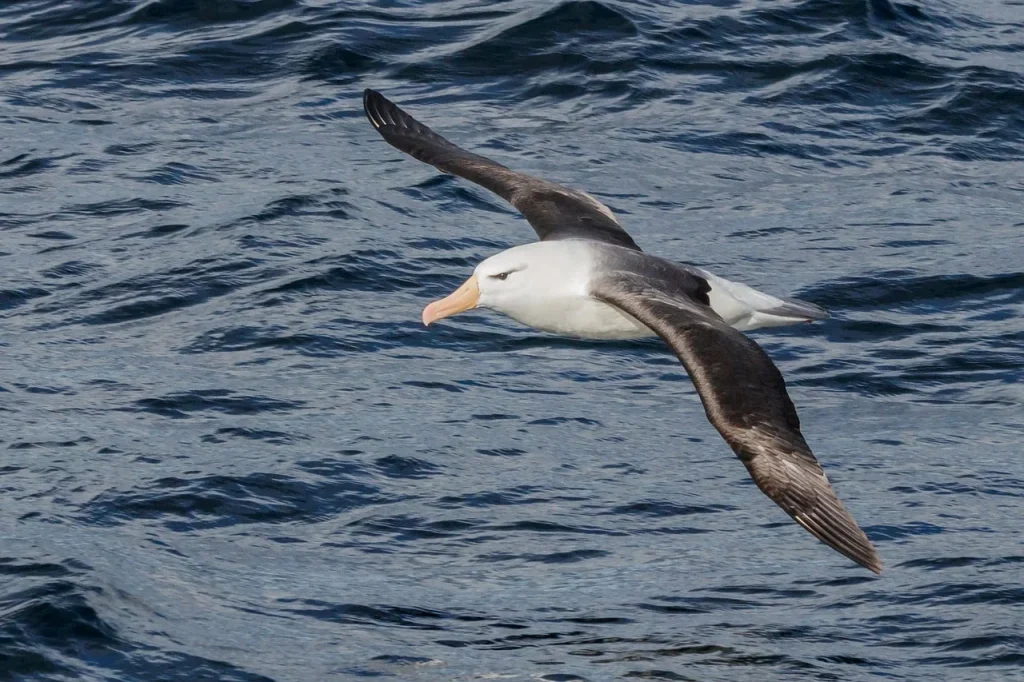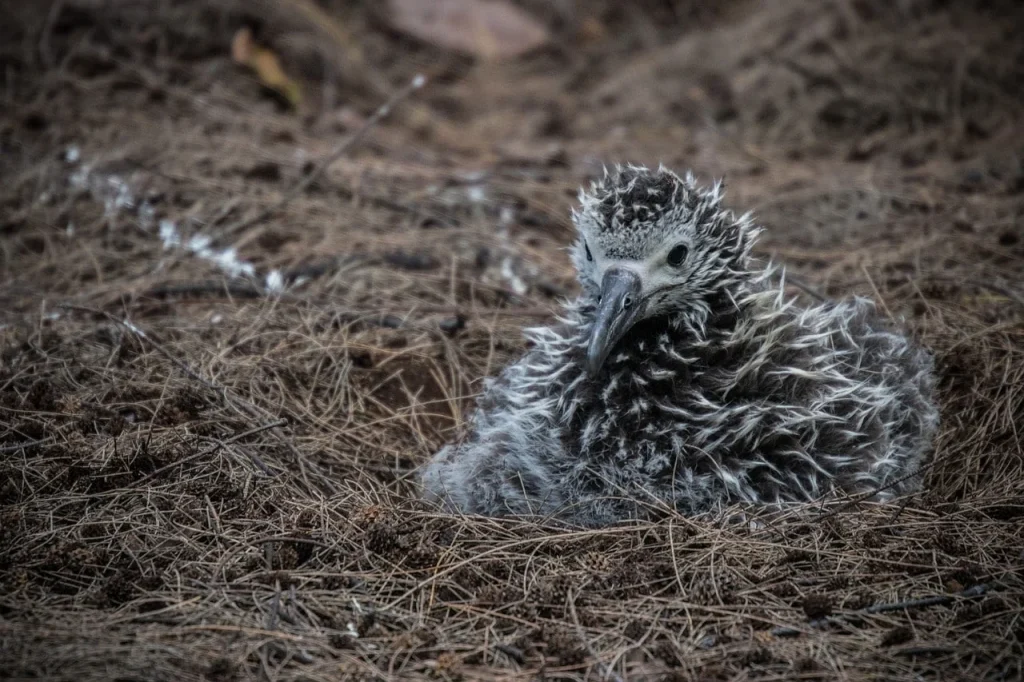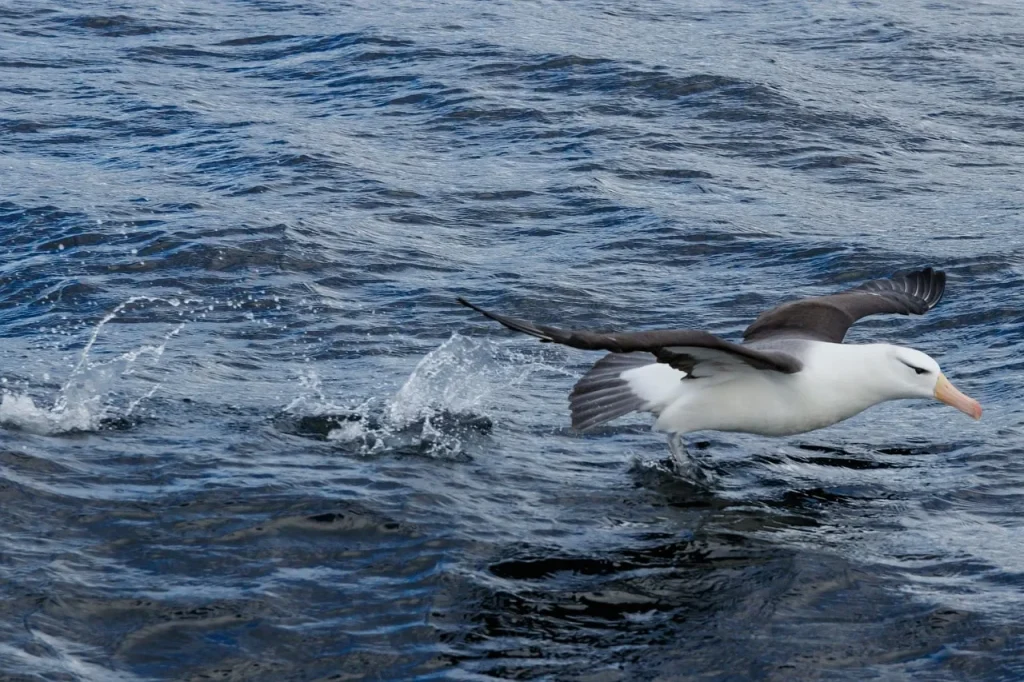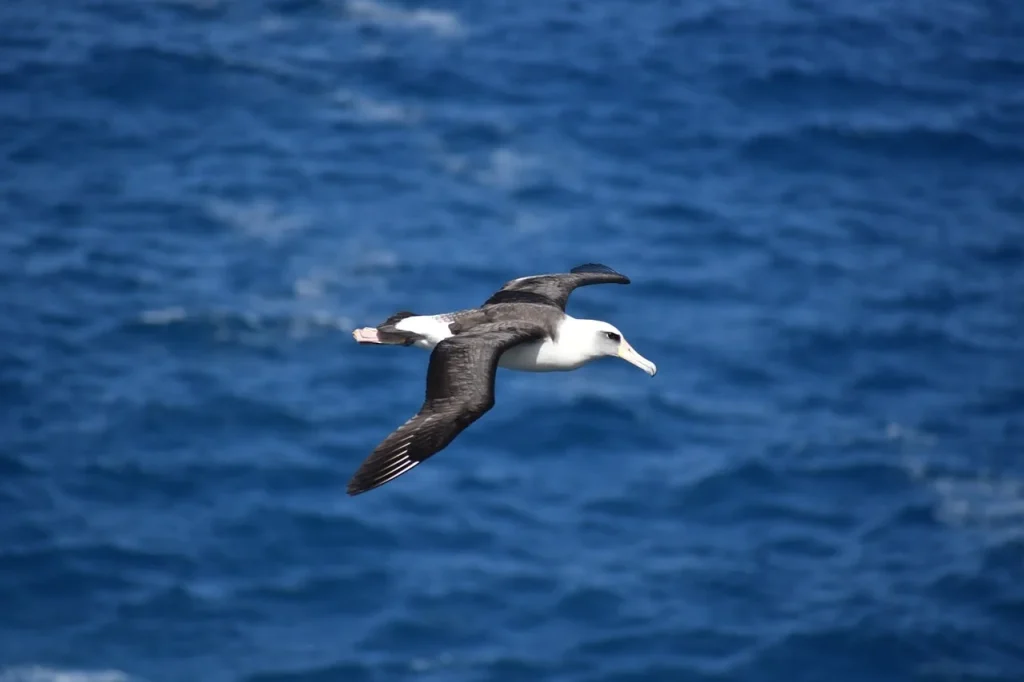What if I told you there’s a bird that mates for life and dances to win over its partner? Meet the albatross, whose life story reads like a novel full of adventure, romance, and resilience.
As we explore some fascinating facts about these birds, you’ll learn not just about their extraordinary behaviors but also about the challenges they face in a changing world.
I now belong to a higher cult of mortals, for I have seen the albatross!
Robert Cushman Murphy
Albatross Facts
Welcome to our exploration of albatrosses, where you’ll learn details about their remarkable lives. Read carefully, because a quiz awaits at the bottom to see if you’ve become an albatross expert!
- These birds can glide for hours without flapping their wings due to dynamic soaring techniques that exploit wind gradients over the ocean.
- With a wingspan that can reach up to 3.5 meters (11.5 feet), they possess one of the largest wingspans of any bird species.
- Their mating ritual includes a complex dance comprising bill clacking, head bobbing, and mutual preening, which can last up to several years before partnership.
- Their sense of smell is exceptionally keen, which helps them locate squid and fish oils on the ocean surface from miles away.
- Individuals have been known to travel distances equivalent to flying around the Earth three times in a single year.
- They can drink seawater, as specialized glands in their nasal passages filter out salt and expel it from their system.
- Often following ships, they are known to scavenge on garbage or offal discarded from boats, showcasing their opportunistic feeding behavior.
- Their lifespan can reach over 60 years, marking them among the longest-lived birds in the world.
- Chicks take several months to fledge, requiring continuous parental care and feeding, which includes regurgitated food.
- They are a symbol of good luck for sailors and are believed to carry the souls of lost mariners.
- Due to their low reproductive rate and long breeding cycle, population recovery from threats like fishing line entanglements is challenging and slow.
- Some species prefer to nest on isolated islands where there are few land predators.
- The Wandering Albatross has been documented to fly over 10,000 km (about 6,214 miles) in a single journey over the Southern Ocean.

- Their wings are structured to lock in place, allowing them to soar without muscular effort and conserve energy during long flights.
- Siblings can have different fathers, as females may mate with multiple males during a single breeding season.
- The oldest known individual, a Laysan Albatross named Wisdom, was still laying eggs at over 70 years old.
- They play a crucial role in their ecosystem, acting as scavengers that help in the nutrient cycling of marine environments.
- Climate change impacts them by altering wind patterns, which can affect their ability to efficiently forage for food over the ocean.
- Plastic ingestion is a severe threat, as they often mistake floating debris for food, leading to fatal blockages in their digestive systems.
- Global positioning system (GPS) trackers have revealed their ability to navigate with astounding precision across vast oceanic expanses.
- They are considered a key indicator species, with their health providing insights into the overall condition of marine habitats.
- During the breeding season, parents take turns guarding the nest while the other searches for food, sometimes taking trips that last several days.
- In some cultures, their bones and feathers are used in traditional ceremonies and as decorations.
- They are capable of sleeping while flying by taking short naps of around 12 seconds each.
- They exhibit a high degree of site fidelity, returning to the same nesting sites year after year.
- Island conservation efforts often focus on eradicating invasive species to protect nesting grounds and ensure chick survival.
- Pairs communicate through a range of vocalizations and physical gestures unique to their species.
- Their diet primarily consists of squid, which they often catch during nighttime.

- Fossil records suggest that ancient relatives of these birds lived over 50 million years ago.
- Their wing-loading (weight relative to wing area) is among the lowest of any bird, facilitating their extensive soaring capabilities.
- Breeding pairs are mostly monogamous, often reuniting year after year during breeding season.
- Their habitat spans from the southern tips of South America and Africa to the remotest parts of the Southern Ocean.
- Researchers use feather samples to study their migration patterns and feeding ecology through stable isotope analysis.
- Entanglement in fishing gear, particularly longlines, remains a critical threat, causing hundreds of fatalities annually.
- Their beaks are adapted with sharp hooks at the end, making them ideal for holding slippery prey.
- Their breeding colonies are often located on steep, rocky cliffs, where they can take off and land into the wind more easily.
- They play an essential role in the lore and mythology of many indigenous Polynesian cultures.
- Conservation programs sometimes involve translocating chicks to establish new colonies in areas free of predators.

- Bycatch reduction devices on fishing gear have been developed to help prevent accidental catches in fisheries.
- Adults may spend up to 95% of their life at sea, coming to land only to breed and raise their young.
- They are highly vulnerable to changes in sea surface temperature, which can affect the abundance of their prey species.
- Their eyesight is exceptionally sharp, adapted for spotting prey from high above the ocean.
- Chicks are prone to predation by introduced species such as rats and feral cats on many islands.
- They have a delayed maturity, often not breeding until they are around 10 years old, which affects population growth rates.
- Illegal fishing and pollution in remote parts of the world pose significant risks to their populations.
- They use the Earth’s magnetic field as part of their navigation system, helping them traverse the globe with precision.
- Their slow flapping flight is energy-intensive, but they are capable of switching to more efficient gliding as needed.
- Community science projects involve volunteers in tracking sightings and monitoring breeding success to aid conservation efforts.
- Their courtship displays are among the most elaborate of any bird species, involving synchronized movements that can include dozens of different motions and vocalizations.
- Tagging studies have shown that juvenile birds undertake extensive solitary flights across the ocean to explore and establish their own feeding territories before returning to breed.
Albatross Myths

Now that we’ve explored the facts, let’s continue with some of the myths surrounding these majestic birds. It’s time to separate fact from fiction and uncover the truth.
- Albatrosses Are Bad Luck for Sailors
This superstition was popularized by Samuel Taylor Coleridge’s poem “The Rime of the Ancient Mariner.” In reality, albatrosses are often seen as omens of good luck, guiding sailors through rough seas. - Albatrosses Mate for Life
It is commonly believed that they mate for life. While they are highly monogamous, partnerships can be broken by death or reproductive failure. New mates are sometimes chosen subsequently. - Albatrosses Can Sleep While Flying
This myth stems from their ability to glide for hours without visible effort. However, it is not confirmed scientifically that sleep is engaged in while they are in flight. Brief rests and naps might be taken on the water’s surface. - Albatrosses Can’t Walk Properly
Although they are better adapted to life in the air and can appear awkward on land, they are capable of walking and maneuvering effectively, especially when nesting and caring for chicks. - Albatrosses Spend Their Entire Life at Sea
While they do spend a significant portion of their lives flying over oceans, they must come ashore to breed and rear their young. Nesting colonies are established on remote islands where disturbances are minimized.
No products found.
Albatross Quotes

We continue our journey with some quotes. As always, you can share yours in the comments, and I will add them to the list.
The albatross is a proud bird, even in captivity; its captivity is a form of protest.
Jacques Cousteau
Cousteau, a renowned oceanographer, commented on the indomitable spirit of the albatross, emphasizing its natural inclination for freedom and its discomfort in confinement.
To fly as fast as thought, to anywhere that is, you must begin by knowing that you have already arrived… This is the way of the albatross.
Richard Bach
In his philosophical reflections, Bach uses the albatross as a symbol for transcending physical limits and achieving one’s dreams, likening it to limitless potential.
The albatross is the prince of the waves, a regal bird, unfettered by the bonds of land.
Sir David Attenborough
Attenborough, a famed naturalist, describes the albatross with admiration, focusing on its mastery of the ocean winds and its life spent mostly at sea.
An albatross around the neck
Samuel Taylor Coleridge
From Coleridge’s “The Rime of the Ancient Mariner,” this phrase has become a metaphor for a burdensome guilt or curse, originally depicted as a punishment for the mariner who killed an albatross.
The albatross teaches us that solitude and endurance can be noble qualities, not merely lonely ones.
Yann Martel
Martel, author of thought-provoking novels, portrays the albatross as a figure of resilience and noble solitude, surviving in the vast and hostile environment of the open sea.
Albatross FAQ

We are one section away from the quiz. Read carefully these FAQs if you want to score a perfect ten.
- Can albatrosses swim?
Yes, they can swim! They are often seen floating on the ocean’s surface and use their strong legs to paddle. However, their primary element is the air, where they excel at soaring for hours without flapping their wings. - Are albatrosses endangered?
Many species of albatrosses are indeed endangered. Factors like habitat loss, pollution, and particularly interactions with fishing industries have significantly impacted their populations. Conservation efforts are ongoing to help protect these majestic birds. - Can albatrosses sleep while flying?
Yes, they can sleep while flying! They have the remarkable ability to sleep in very short bursts while cruising over the ocean. This adaptation allows them to remain in the air for extended periods without landing. - How do albatrosses mate?
They mate for life, forming long-lasting bonds with their partners. They engage in elaborate courtship rituals, which include synchronized dancing, mutual preening, and vocalizations, to strengthen their pair bonds each breeding season. - Why are albatrosses called love birds?
They are often referred to as “love birds” because of their lifelong monogamy. They are known for their enduring partnerships, where they meet up with their mates every breeding season, despite spending long periods apart, roaming the vast oceans.
No products found.
Albatross Trivia

Welcome to the soaring skies of the albatross quiz! Better buckle up; if you don’t score any points, you might just find yourself wearing wings and catching fish for dinner!
Albatross Merch
If you are a true fan of albatrosses, then you definitely need to check out our merchandise. You can find T-shirts, hoodies, mugs, and tote bags for your favorite designs. Feel free to check out all the other designs in our shop.
Conclusion
The albatross is a bird that commands respect, not just for its size but for its remarkable life journey. Soaring across the oceans, these birds face many challenges, from long-distance travel to raising their young in harsh environments.
Yet, they endure and continue to fascinate us with their graceful flights. Let’s keep our oceans clean and safe for the albatross and all marine life that depends on them. Till next time, stay curious and explore more. Cheers.


